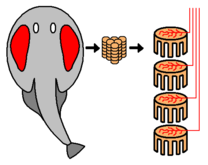Electric ray
| Electric rays Temporal range:
| |
|---|---|

| |
| Marbled electric ray (Torpedo marmorata) | |

| |
| Lesser electric ray (Narcine bancroftii) | |
| Scientific classification | |
| Domain: | Eukaryota |
| Kingdom: | Animalia |
| Phylum: | Chordata |
| Class: | Chondrichthyes |
| Subclass: | Elasmobranchii |
| Superorder: | Batoidea |
| Order: | Torpediniformes F. de Buen , 1926
|
| Families | |
The electric rays are a group of
Perhaps the best known members are those of the genus Torpedo. The torpedo undersea weapon is named after it. The name comes from the Latin torpere, 'to be stiffened or paralyzed', from the effect on someone who touches the fish.[3]
Description
Electric rays have a rounded pectoral disc with two moderately large rounded-angular (not pointed or hooked)
Electric rays are found from shallow coastal waters down to at least 1,000 m (3,300 ft) deep. They are sluggish and slow-moving, propelling themselves with their tails, not by using their pectoral fins as other rays do. They feed on invertebrates and small fish. They lie in wait for prey below the sand or other substrate, using their electricity to stun and capture it.[5]
Relationship to humans
History of research
The electrogenic properties of electric rays have been known since antiquity, although their nature was not understood. The ancient Greeks used electric rays to numb the pain of childbirth and operations.[2] In his dialogue Meno, Plato has the character Meno accuse Socrates of "stunning" people with his puzzling questions, in a manner similar to the way the torpedo fish stuns with electricity.[6] Scribonius Largus, a Roman physician, recorded the use of torpedo fish for treatment of headaches and gout in his Compositiones Medicae of 46 AD.[7]
In the 1770s the electric organs of the torpedo ray were the subject of Royal Society papers by John Walsh,[8] and John Hunter.[9][10] These appear to have influenced the thinking of Luigi Galvani and Alessandro Volta – the founders of electrophysiology and electrochemistry.[11][12] Henry Cavendish proposed that electric rays use electricity; he built an artificial ray consisting of fish shaped Leyden jars to successfully mimic their behaviour in 1773.[13]
In folklore
The torpedo fish, or electric ray, appears continuously in premodern natural histories as a magical creature, and its ability to numb fishermen without seeming to touch them was a significant source of evidence for the belief in
Bioelectricity
The electric rays have specialised
Systematics
The 60 or so species of electric rays are grouped into 12 genera and two families.[19] The Narkinae are sometimes elevated to a family, the Narkidae. The torpedinids feed on large prey, which are stunned using their electric organs and swallowed whole, while the narcinids specialize on small prey on or in the bottom substrate. Both groups use electricity for defense, but it is unclear whether the narcinids use electricity in feeding.[20]
- Family Narcinidae (numbfishes)
- Subfamily Narcininae
- Genus Benthobatis
- Genus Diplobatis
- Genus Discopyge
- Genus Narcine
- Subfamily Narkinae(sleeper rays)
- Genus Crassinarke
- Genus Electrolux
- Genus Heteronarce
- Genus Narke
- Genus Temera
- Genus Typhlonarke
- Genus
- Subfamily Narcininae
- Family Hypnidae (coffin rays)
- Family Torpedinidae (torpedo electric rays)
- Subfamily Torpedininae
- Genus Tetronarce
- Genus Torpedo
- Subfamily Torpedininae
See also
- Endangered rays
- Electric fish
References
- ^ Froese, Rainer, and Daniel Pauly, eds. (2011). "Torpediniformes" in FishBase. February 2011 version.
- ^ a b c d e f Martin, R. Aidan. "Electric Rays". ReefQuest Centre for Shark Research. Archived from the original on 15 October 2008. Retrieved 12 October 2008.
- ISBN 0-00-458641-7.
- ISBN 0-8018-6048-2.
- ISBN 0-12-547665-5.
- ^ Wikisource:Meno
- ISBN 978-0-387-28275-6.
- ^ Walsh, John (1773). "On the Electric Property of the Torpedo: in a Letter to Benjamin Franklin". Philosophical Transactions of the Royal Society of London (64): 461–480.
- ^ Hunter, John (1773). "Anatomical Observations on the Torpedo". Philosophical Transactions of the Royal Society of London (63): 481–489.
- ^ Hunter, John (1775). "An account of the Gymnotus electricus". Philosophical Transactions of the Royal Society of London (65): 395–407.
- PMID 4895861.
- ^ Edwards, Paul (10 November 2021). "A Correction to the Record of Early Electrophysiology Research on the 250 th An- niversary of a Historic Expedition to Île de Ré". HAL open-access archive. Retrieved 6 May 2022.
- ^ Al-Khalili, Jim. "Shock and Awe: The Story of Electricity". BBC. Retrieved 9 June 2022.
- PMID 11622951.
- ^ Bigelow, H. B.; Schroeder, W. C. (1953). Fishes of the Western North Atlantic, Part 2. Sears Foundation for Marine Research, Yale University. pp. 80–104.
- ISBN 0-520-22149-4.
- ISBN 978-3-540-23735-8. Retrieved 2012-03-25.
- ISBN 0-7614-7266-5.
- ISBN 0-471-25031-7.
- ^ Compagno, Leonard J.V. and Heemstra, Phillip C. (May 2007) "Electrolux addisoni, a new genus and species of electric ray from the east coast of South Africa (Rajiformes: Torpedinoidei: Narkidae), with a review of torpedinoid taxonomy". Smithiana, Publications in Aquatic Biodiversity, Bulletin 7: 15-49. Retrieved on October 22, 2008.


